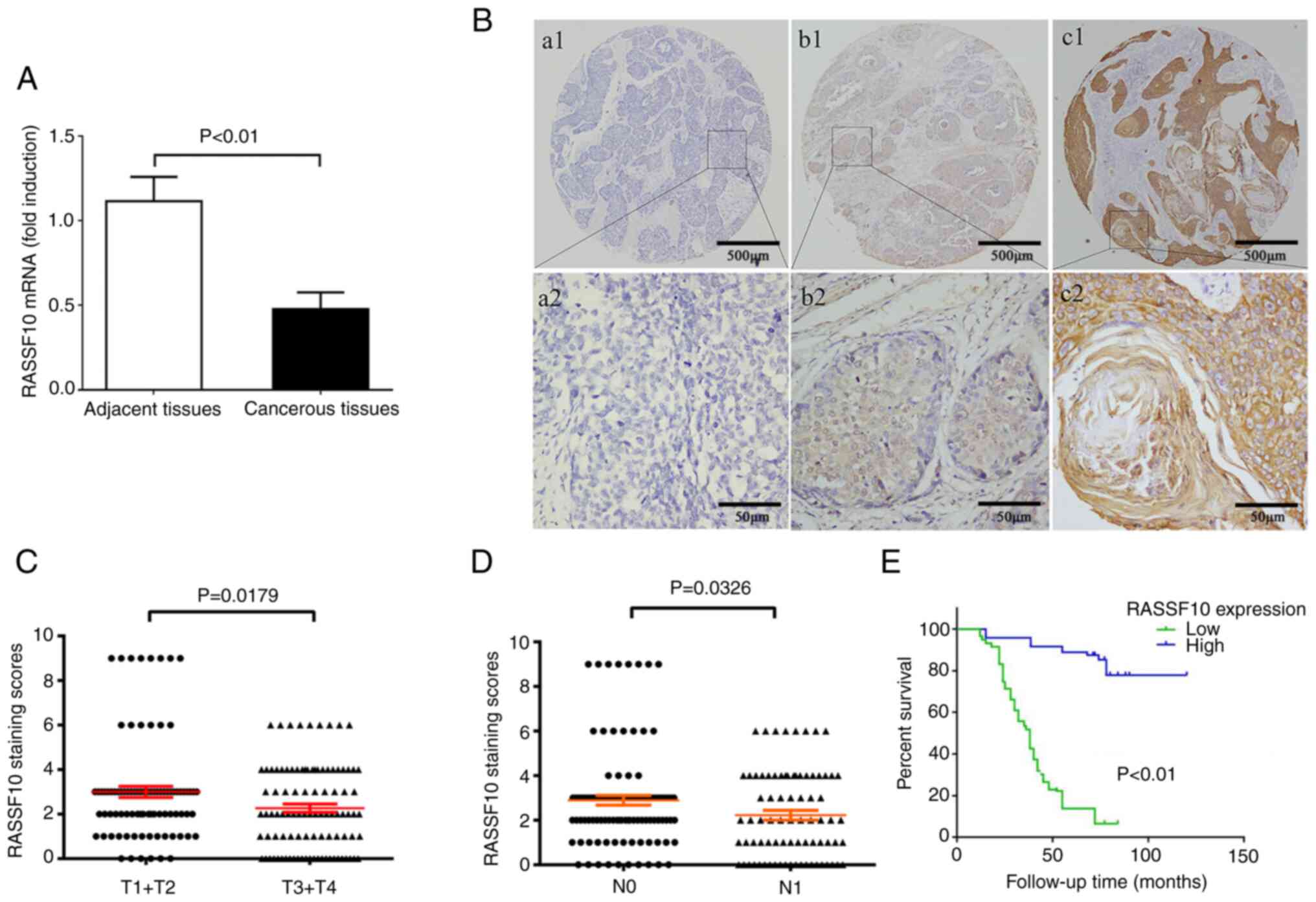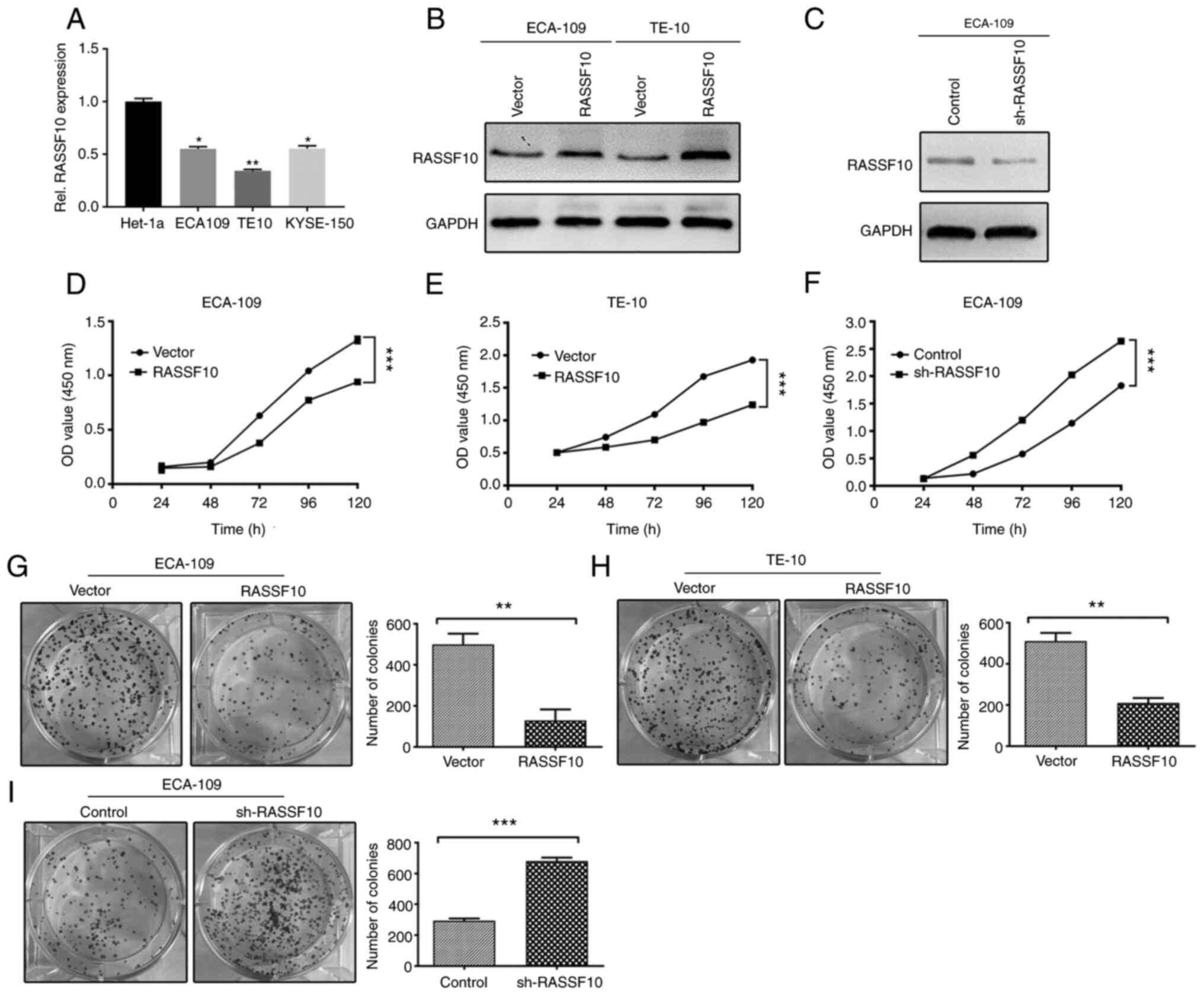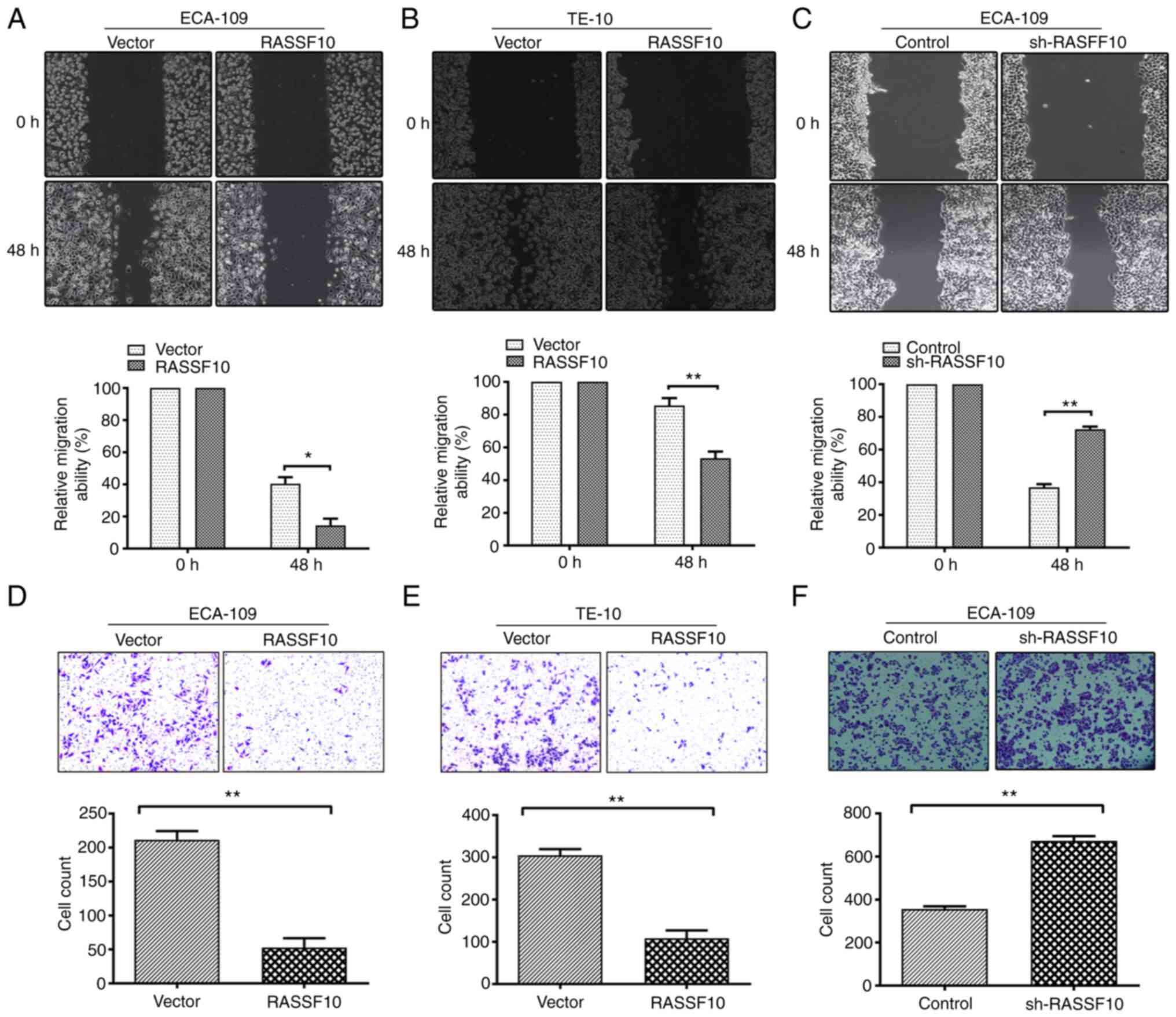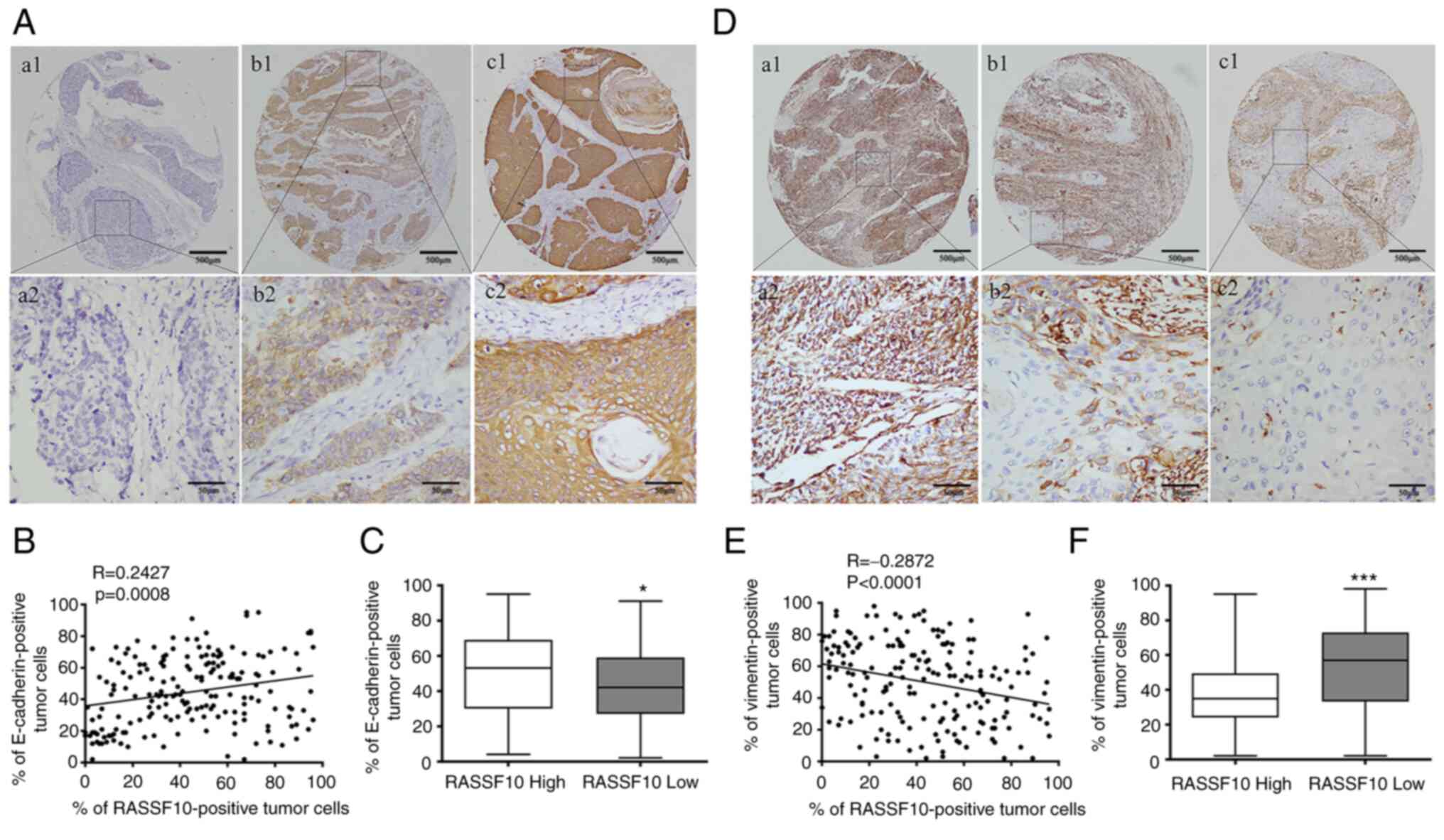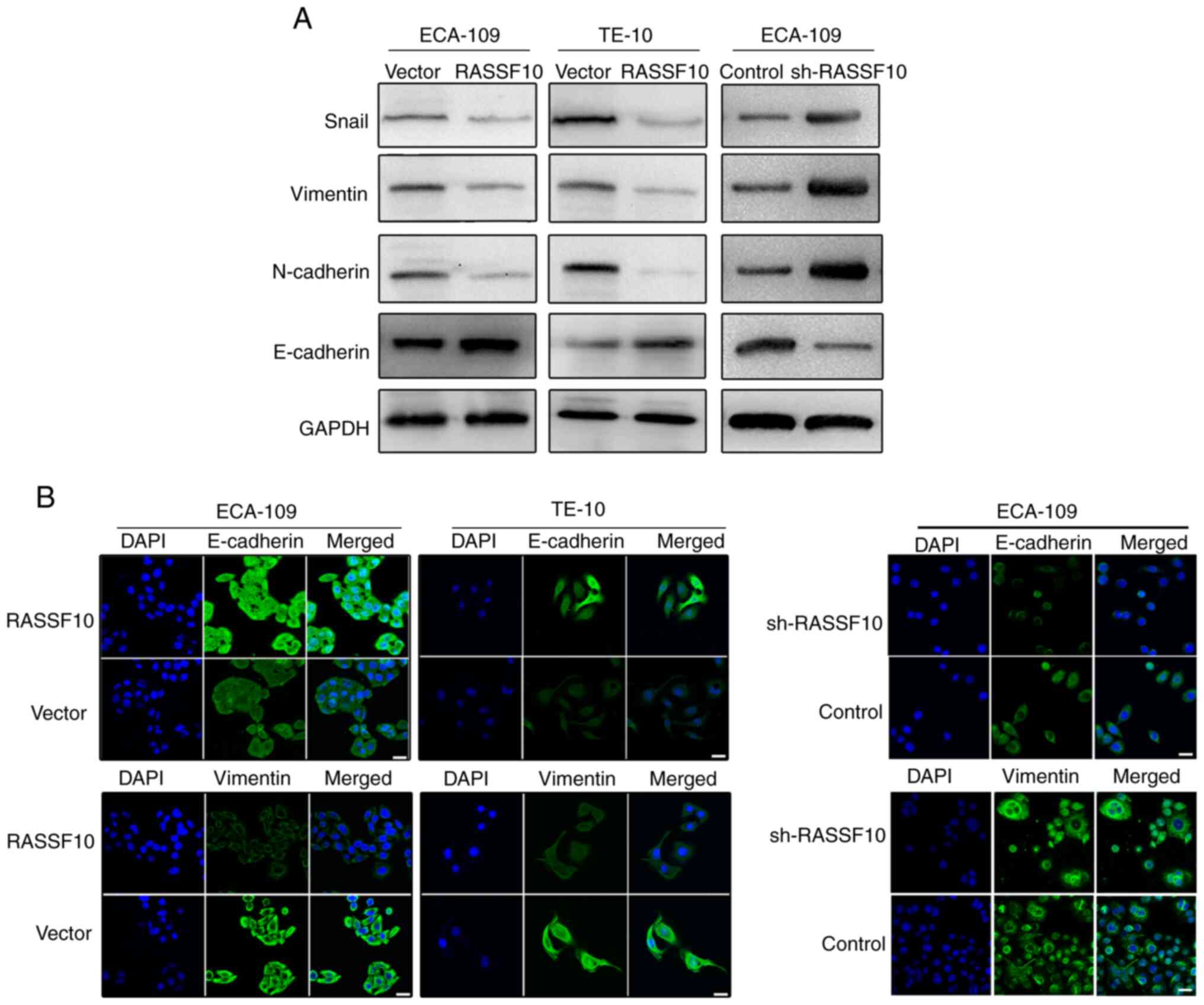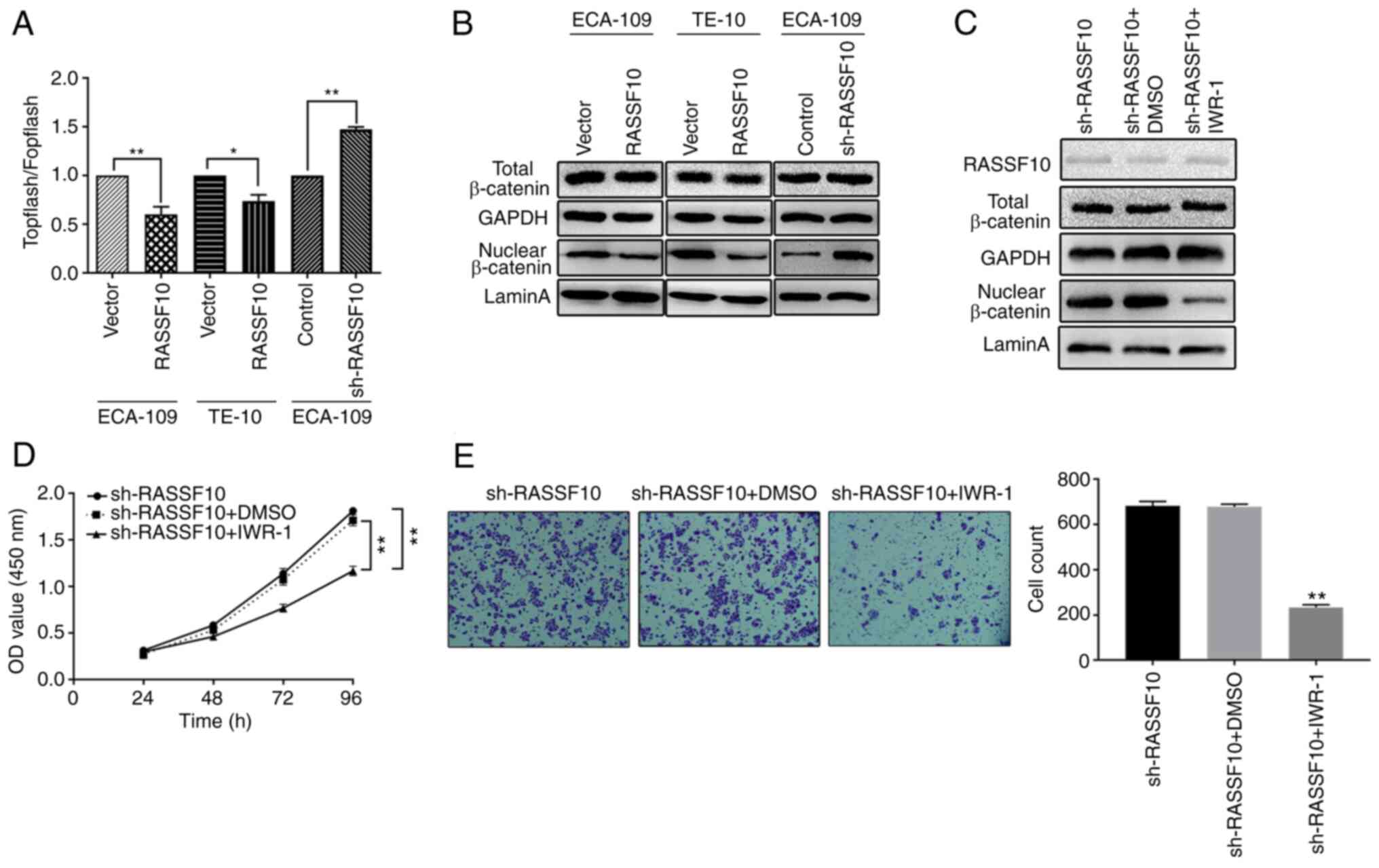RASSF10 exhibits tumor‑suppressing potential involving tumor proliferation, metastasis and epithelial‑mesenchymal transition in esophageal squamous cell carcinoma
- Authors:
- Published online on: February 22, 2022 https://doi.org/10.3892/or.2022.8291
- Article Number: 80
-
Copyright: © Liu et al. This is an open access article distributed under the terms of Creative Commons Attribution License.
Abstract
Introduction
Esophageal cancer (EsC) ranks seventh among all malignancy-related deaths worldwide (1). The prognosis of esophageal malignancies is particularly poor because these tumors typically do not cause any symptoms in the early stages. Therefore, most EsC patients are diagnosed with advanced stages of the diseases which are accompanied by distant metastasis, making them ineligible for radical surgery (2,3). This complication leads to a low 5-year survival rate, and although this rate has increased over time, it remains at only 18% (2). Esophageal squamous cell carcinoma (ESCC) is the dominant histological type of EsC in southeastern Asia, especially in China (4). The risk factors for chronic cell damage include smoking, alcohol abuse, thermal damage and nutrient deficiencies. Furthermore, infiltration and metastasis are the two main causes of death from ESCC (2,5). Recent studies have revealed that tumor cells affect the surrounding microenvironment, pierce through the surrounding barrier, migrate into peritumoral tissues from the primary site, and contribute to regional invasion and widespread metastasis (6). However, the concrete mechanisms by which ESCC metastasizes remains unknown. Thus, identification of the potential specific biomarkers involved in tumor metastasis will help improve the chances of an early diagnosis, formulate appropriate clinical treatment plans and prolong the survival of ESCC patients.
Ras-association domain family 10 (RASSF10) located on chromosome 11p15.2, is both a candidate tumor-suppressor gene and the latest identified member of the RASSF family (7,8). RASSF10, as well as RASSF7-9 of this family, which share a conserved Ras association domain in the N-terminal region, demonstrate several tumor-suppressive properties (8,9). Accumulating evidence suggests that downregulation or inactivation of RASSF10 by hypermethylation is extensively involved in the promotion of cell proliferation and metastasis, which has been observed in many human malignancies, such as astrocytic glioma, malignant melanoma of the skin, hepatocellular carcinoma, thyroid cancer and childhood acute lymphoblastic leukemia (10–14). However, to the best of our knowledge, further studies of the association between RASSF10 and ESCC, including the clinical significance and cellular biological mechanisms underlying the participation of RASSF10 in these malignant phenotypes, are urgently warranted.
In the present study, we aimed to investigate the clinical value of RASSF10 expression in ESCC patients. Furthermore, on the strength of previous research on RASSF10, the potential functions of RASSF10 in ESCC were investigated.
Materials and methods
Tissue specimens
This project was authorized by permission of the Ethics Committee of the Affiliated Hospital of Nantong University (Nantong, China), and signed informed-consent forms were collected from all patients. Relevant clinical data on each patient were collected from his or her medical records. The ESCC tissues and paired normal adjacent mucosa tissues were derived from 187 ESCC patients who had undergone surgery at the Affiliated Hospital of Nantong University between January 2008 and December 2014. The mean age of patients at the time of surgery was 53.81 years (range, 21–88 years). The percentage of male or female patients accounted for 67.91 and 32.09% of the ESCC patients, respectively. Histological classifications and stages per the TNM Classification of Malignant Tumors (TNM stages) (https://www.uicc.org/resources/tnm-classification-malignant-tumours-8th-edition) were determined independently by two senior pathologists according to the classification criteria of the American Joint Committee on Cancer. Resected samples were snap-frozen in liquid nitrogen until RNA and protein extraction could be performed. After the enrolled ESCC patients underwent surgery, they were treated in strict accordance with therapeutic schedule on the basis of ESCC treatment guidelines. The ESCC patients who were diagnosed with pathologically confirmed lymph node metastases were able to select treatment with chemotherapy of 2–4 cycles. Chemoradiotherapy using albumin bound paclitaxel plus platinum antineoplastic agent was used in the treatment of the patients with ESCC.
Cell lines and transfection
We purchased the normal esophageal epithelium cell line Het-1a and ESCC cell lines (TE-10, ECA-109 and KYSE-150) from the Shanghai Institute for Biological Sciences, Chinese Academy of Sciences. Het-1a, TE-10, ECA-109 and KYSE-150 cells were maintained in RPMI-1640 or DMEM, supplemented with 10% fetal bovine serum (FBS), ampicillin (50 U/ml) and streptomycin (50 µg/ml), in a humidified chamber at 37°C with 5% CO2. Notably, TE-10 and ECA-109 cells were transfected with plasmids encoding RASSF10, or shRNA against RASSF10, along with a vector control. The cDNA encoding full-length human RASSF10 was cloned into the PCDH vector. The shRNA targeting sequence for RASSF10 was 5′-GGAAAUUCCUUGAAUGUUAAU-3′. The expression constructs were verified by DNA sequencing. RASSF10 expression in the transfected cells was validated by western blot analysis.
RNA isolation and quantitative real-time polymerase chain reaction (qPCR)
Total RNA isolation and qPCR analyses of RASSF10 expression were performed as previously reported (15). The relative mRNA expression levels of RASSF10 were calculated in human tissues using the 2−ΔΔCq method (16). The primer sequences of RASSF10 were designed as follows: forward primer (5′-CAGAGCAGGGTGAGGGTAGA-3′) and reverse primer (5′-GCTCGGACCACGTCAATTTC-3′). The primer sequences of GAPDH were designed as follows: forward primer (5′-CAGGAGGCATTGCTGATGAT-3′) and reverse primer (5′-GAAGGCTGGGGCTCATTT-3′). All experiments were repeated three times.
Immunohistochemistry (IHC) analysis
For the streptavidin-peroxidase (S-P) IHC studies, the primary antibodies were as follows: anti-RASSF10 (1:200; cat. no. Ab113105; Abcam), anti-E-cadherin (1:500; cat. no. ab40772; Abcam) and anti-vimentin (1:500; cat. no. ab8978; Abcam). Staining intensity and the fraction of positive cells were scored according to 10 randomly selected visual fields. The immunoreactive scores (IRS) for the proportion of positive cells and the staining grade were calculated for each specimen.
Scoring criteria
The percentages of positive cells were calculated as follows: 0 (≤5%), 1 (>5–25%), 2 (>25–50%) and 3 (>50%). Staining intensity was quantified according to four classification: 0 (negative), 1 (weak positive), 2 (moderate positive), and 3 (strong positive). According to the scoring criteria above, the expression levels of RASSF10 or E-cadherin or vimentin in the ESCC tissues were classified into two groups: samples with IRS >3 defined as high expression and the samples with IRS ≤3 defined as low expression.
Protein extraction and western blot analysis
Protein isolation and western blot analysis were performed as previously reported (17). The following commercial antibodies against RASSF10 (1:500; cat. no. Ab113105), E-cadherin (1:20,000; cat. no. Ab40772), vimentin (1:2,000; cat. no. Ab8978), β-catenin (1:3,000; cat. no. Ab16051), GAPDH (1:3,000; cat. no. Ab9485) and Lamin A (1:5,000; cat. no. Ab226198) followed by secondary antibody antibodies (1:5,000; cat. no. Ab6728; 1:10,000; cat. no. Ab6728) purchased from Abcam were used. All experiments were repeated three times.
Cell proliferation assay
Cell proliferation was monitored using the Cell Counting Kit-8 (CCK-8) based on the manufacturer's protocol (Dojindo). The transfected ESCC cell lines (TE-10 and ECA-109) were incubated at a density of 3,000 cells per well in a 96-well plate. Cell viability was determined at daily intervals (every 24 h) following the absorbance measured at 450 nm. All experiments were repeated three times.
Colony formation assay
For the colony formation assay, the transfected ESCC lines (TE-10 and ECA-109) in the logarithmic growth phase were plated into 6-well plates at a density of 300 cells per well and maintained for two weeks in medium containing G418 (1,000 µg/ml). The colonies were washed with PBS three times, and then fixed with paraformaldehyde and stained with crystal violet (0.1%) at 25°C for 10 min. The colony formation was measured by photographing the stained colonies under a microscope (magnification, ×5; Olympus Corp.). Colony formation was assessed using MShot Image Analysis System (Guangzhou Mingmei Photoelectric Technology Co., Ltd.). All experiments were repeated three times.
Immunofluorescence
Immunofluorescence staining analysis was performed as previously reported using a confocal laser-scanning microscope (Carl Zeiss) (18). To assess the protein subcellular localization, the data were analyzed with Adobe Photoshop 7.0 software.
Luciferase reporter assay
TOPflash/FOPflash reporters (Millipore) were used in this assay. The cells were transiently transfected with 1 mg of either TOPFlash or FOPFlash, and 0.1 mg pRLTK (Renilla-TK-luciferase vector, Promega Corp.) following the manufacturer's protocol. Firefly and Renilla luciferase activities were conducted employing the Dual-Luciferase Reporter Assay System (Promega Corp.) after a 48-h transfection. The activity of firefly luciferase was normalized to that of Renilla luciferase as a transfection control. All experiments were repeated three times.
Transwell invasion assays
Cell motility was determined by cell invasion assays using 8-µm Transwell filters (BD Biosciences) with Matrigel (BD Biosciences). The treated ECA109 and TE-10 cells at a density of 5×104 were seeded into the upper chamber with medium that did not contain serum; medium containing serum was placed into the lower chambers as a chemoattractant. After incubation for 48 h, the treated cells on the upper surface of the membrane were stained with crystal violet (0.1%) at 25°C for 10 min followed by manual counting under a microscope (magnification, ×20; Olympus Corp.) in three randomly selected areas. The Transwell assays were assessed using MShot Image Analysis System (Guangzhou Mingmei Photoelectric Technology Co., Ltd.). All experiments were repeated three times.
Wound healing assay
TE-10 and ECA-109 cells were plated onto 6-well plates to encourage the formation of a monolayer of cells. A 200-µl pipette tip was employed to vertically scratch the cells in the middle of the well. The floating debris was then washed away. Fresh medium containing 0.1% FBS was supplemented and images of the cells were taken with a light microscope (magnification, ×100; Olympus Corp.) at 0 and 48 h to determine cell migration. The wound healing assays were assessed using MShot Image Analysis System (Guangzhou Mingmei Photoelectric Technology Co., Ltd.). All experiments were repeated three times.
Inhibitor treatment
The Wnt inhibitor IWR-1 was purchased from ENZO. Approximately 24 h before transfection, the treated ECA109 cells were plated in 6-well plates at 35–55% confluence. Cells were then transfected with the Wnt inhibitor IWR-1 at a working concentration of 10 µM, respectively, using Lipofectamine 2000 (Invitrogen; Thermo Fisher Scientific, Inc.) according to the manufacturer's protocol. After 48–72 h, the cells were collected for subsequent experiments.
Statistical analysis
Statistical analysis was carried out using SPSS software 22.0 (SPSS, Inc.) and GraphPad Prism 5.0 software (GraphPad Software, Inc.). The Chi-squared test or Student's t-test was employed to compare the differences between two groups. Spearman rank correlations test was used to detect the relationship between expression of two genes. Other data were evaluated employing the Mann-Whitney U test as applicable to determine significant differences. Univariate and multivariate Cox regression model analyses were used to determine the prognostic relevant factors. Kaplan-Meier method was used to calculate the survival function and draw the survival curve. A P-value <0.05 was considered statistically significant.
Results
RASSF10 is downregulated in human ESCC tissues
To explore the clinical significance of RASSF10 in ESCC progression, qPCR was employed to measure the expression of the RASSF10 mRNA level extracted from the collected 20 pairs of ESCC patient tissues and matched adjacent normal tissues. Our results revealed that the RASSF10 mRNA expression level in the ESCC cancerous tissue samples was significantly downregulated compared with that in the corresponding adjacent normal tissue samples (Fig. 1A, P<0.01). TMA-IHC was further conducted to determine the RASSF10 protein status on a cohort of 187 samples of ESCC tissues and 154 peritumoral tissues. The distribution of the different levels of RASSF10 expression in ESCC and peritumoral tissues is shown in Table I. The expression levels of RASSF10 were markedly higher in the peritumoral tissue samples than that in the tumor tissues (P<0.001). Our results indicated that the RASSF10 protein was mainly localized in the cytoplasm of ESCC cells (Fig. 1B). These results demonstrated that RASSF10 is downregulated in ESCC.
Clinical significance of RASSF10 in ESCC
Furthermore, we assessed the association between activated cytoplasmic RASSF10 expression and the clinical pathological parameters in ESCC patients. The data demonstrated that RASSF10 was markedly associated with differentiation (P=0.001) (Fig. 1B), primary tumor (P=0.014), lymph node metastasis (P=0.02) and TNM stage (P 0.006) (Table II). As shown in Fig. 1C, the immunoreaction scores of the RASSF10 status in T3-T4 stages was markedly lower in comparison with that of T1-T2 stages (P=0.0179). It was also found that ESCC patients who developed metastasis had markedly lower immunoreaction scores for RASSF10 compared with than those of non-metastatic patients (P=0.0326) (Fig. 1D).
Next, Kaplan-Meier analysis combined with IHC analysis demonstrated that low expression of RASSF10 was correlated with poor overall survival in ESCC patients (P<0.01) (Fig. 1E). As shown in Table III, multivariate Cox regression analysis confirmed that low cytoplasmic RASSF10 expression was a marked independent prognostic factor (P=0.002). Collectively, our results indicated that there is a convincing association between low RASSF10 expression and poor outcome in ESCC patients.
Table III.Univariate and multivariate analysis of the association of prognosis with the clinicopathologic parameters and RASSF10 expression in the ESCC patients. |
Effect of RASSF10 on ESCC cell proliferation
To explore the role of RASSF10 in the progression of ESCC, endogenous expression of RASSF10 was assessed by qPCR in normal esophageal epithelium cell line Het-1a and human ESCC cell lines TE10, ECA109 and KYSE-150. RASSF10 mRNA levels were lower in ESCC cell lines compared with that in the Het-1a cells (Fig. 2A). We then generated stable infected ECA-109 and TE-10 cells with RASSF10 overexpression, and the ECA-109 cell line was selected to silence RASSF10 expression. Western blot analysis was used to verify the transfection efficiency of the treated cell lines (Fig. 2B and C). Increased proliferation is one of most malignant phenotypes of cancer cells and plays an important part in cancer progression (19). Thus, CCK-8 and colony formation assays were used to evaluated the proliferative capabilities of the mentioned cell models. As shown in Fig. 2D and E, ectopic expression of RASSF10 dramatically suppressed the cell growth of the ECA-109 and TE-10 cells compared with the empty vector group, and the number of colonies which had formed in the RASSF10-transfected ECA-109 and TE-10 cells were significantly decreased in keeping with this finding (Fig. 2G and H), In contrast, RASSF10 knockdown resulted in markedly reverse effects (Fig. 2F and I). These results suggest that RASSF10 is crucial for inhibiting ESCC cell growth.
Effect of RASSF10 on ESCC cell migration and invasion
Since increased capability for motility is indispensable for tumor metastasis, wound healing and Transwell invasion assays were performed. Ectopic expression of RASSF10 significantly inhibited cell migration capability in the ECA-109 and TE-10 cells compared with the vector-transfected cells (Fig. 3A and B). The RASSF10-expressing cells exhibited a marked decrease in reduction in wound closure in comparison with the control groups by quantitative analyses at 48 h. By comparison, knockdown of RASSF10 significantly facilitated the migration of ECA-109 cells (Fig. 3C). Transwell invasion assays were also conducted. As expected, it was demonstrated that RASSF10 overexpression markedly impaired the invasive capability of the ECA-109 and TE-10 cells compared with that of the control groups while RASSF10 knockdown increased the invasive ability of the cells (Fig. 3D-F). Taken together, our results indicated the capability of RASSF10 to inhibit ESCC cell migration and invasion.
Correlation between RASSF10 and EMT biomarkers in ESCC tissues and cell lines
A growing body of studies have revealed that EMT plays a crucial part in ESCC invasion and metastasis cascade, and our above-mentioned results suggested that decreased expression of RASSF10 was correlated with tumor metastasis in ESCC patients (20–22). Therefore, we investigated the protein expression levels of EMT markers, E-cadherin (epithelial phenotype) and vimentin (mesenchymal phenotype), using the same TMA samples to further explore the role of RASSF10 in the EMT process in ESCC. IHC analysis demonstrated that tumors with lower RASSF10 expression exhibited lower E-cadherin expression levels and higher vimentin expression levels (Fig. 4A and D). According to the Spearman rank correlations test, a positive correlation was observed between RASSF10 and E-cadherin (R=0.2427, P=0.0008) (Fig. 4B), and a negative correlation was observed between RASSF10 and vimentin (R=−0.2872, P<0.0001) (Fig. 4E). ESCC patients with lower RASSF10 expression had significantly lower E-cadherin expression than those with higher RASSF10 expression (P=0.0295, Fig. 4C). We also found the ESCC patients with RASSF10 low status exhibited a higher vimentin-positive rate compared with that of the patients with high RASSF10 expression (P=0.0003, Fig. 4F).
To further explore the effect of RASSF10 on the EMT process, western blotting was employed to detect the protein levels of EMT biomarkers. The results indicated that the protein level of E-cadherin was markedly upregulated, while Snail, vimentin and N-cadherin levels were significantly downregulated in the RASSF10-overexpressing cells compared with those in the control group (Fig. 5A). In contrast, knockdown of RASSF10 decreased the expression of E-cadherin and increased the levels of Snail, vimentin and N-cadherin in the ECA-109 cells. These findings suggest that RASSF10 may be involved in suppression of the EMT process. Subsequently, our results using immunofluorescence analysis indicated that the RASSF10-overexpressing cells exhibited higher level of E-cadherin and lower level of vimentin when compared with the control groups (Fig. 5B). Knockdown of RASSF10 reversed this phenotype (Fig. 5B). Our results indicate that RASSF10 may play a crucial part in the regulation of tumor EMT and may control tumor invasion and metastasis by inhibiting the EMT process.
Overexpression of RASSF10 attenuates the Wnt/β-catenin signaling pathway
Previous studies suggest that RASSF10 suppresses gastric cancer cell progression by inhibiting the Wnt/β-catenin signaling pathway (23). Therefore, we hypothesized that inactivation of the Wnt/β-catenin signaling pathway may be involved in the RASSF10-mediated inhibition of ESCC cell progression. In general, the Wnt/β-catenin pathway can be mediated by stabilized accumulation and relocalization of Wnt/β-catenin. We first verified the activities of the Wnt/β-catenin pathway employing TOPflash/FOPflash luciferase assay in ECA-109 and TE-10 cells overexpressing RASSF10. As shown in Fig. 6A, we observed that relative TOPflash/FOPflash luciferase activity was decreased in the ECA-109 and TE-10 cells overexpressing RASSF10 compared with that in the control group; while knockdown of RASSF10 increased the relative TOPflash/FOPflash luciferase activity, which suggested that the Wnt/β-catenin pathway is inactivated by overexpression of RASSF10. Western blot analysis was employed to evaluate the protein levels of β-catenin to further verify the nuclear translocation of β-catenin by separation of the cytoplasmic and nuclear fractions of transfected ESCC cells. Our results indicated that RASSF10 overexpression markedly decreased β-catenin nuclear accumulation (Fig. 6B). We then treated ECA-109 RASSF10-kncokdown cells with IWR-1 inhibitor and observed that the levels of nuclear β-catenin were decreased, although RASSF10 levels remained unchanged (Fig. 6C). We also found that treatment with IWR-1 inhibited cell growth and the migration activity of the ECA109 RASSF10-knockdown cells (Fig. 6D and E). These data demonstrated that RASSF10 overexpression inactivated the Wnt/β-catenin signaling pathway in ESCC.
Discussion
The mechanisms underlying esophageal squamous cell carcinoma (ESCC) occurrence, progression and relapse are intricate. Although the diagnosis and treatment for patients with ESCC have made significant progress, the majority of ESCC patients usually lose the chance of surgery due to diagnosis at advanced or metastatic stage which leads to an unsatisfactory prognosis (2). Metastatic outgrowths from tumor invasion and recurrence usually lead to rapid resistance to therapy (24,25); therefore, it is urgent and beneficial to ESCC patients that we understand the molecular mechanisms correlated with ESCC invasion and metastasis and confirm preventive strategies and therapeutic targets to improve precise prognoses and treatment of the diseases.
In the present study, we found a novel potential biomarker, RASSF10, involved in ESCC invasion and metastasis. RASSF10, belonging to the RASSF family, is a tumor-suppressor gene, which has been revealed to be play crucial roles in inhibition of hepatocellular carcinoma cell invasion and metastasis (21). We found decreased mRNA expression levels of RASSF10 in cancerous tissues when compared with that noted in para-cancerous tissues of ESCC patients, suggesting that RASSF10 functions as a tumor suppressor in ESCC. Based on IHC results, we further confirmed that the protein expression of RASSF10 in ESCC tissues was lower than that in the adjacent tissues. By comparing the immunoreaction scores of RASSF10 in ESCC tissues of various T-tumor and metastatic stages, we found increased RASSF10 in tumors with lower scores of invasion (T1-T2) or in non-metastatic individuals (N0), which suggest that RASSF10 serves as a promising tumor detector. These studies support the anticancer role of RASSF10. ESCC patients with low expression levels of RASSF10 had a markedly worse prognosis in comparison with that of patients with high expression of RASSF10. Moreover, Multivariate Cox regression analysis suggested that RASSF10 is a marked independent prognostic factor. Previous studies have shown that low RASSF10 status contributes to an unfavorable prognosis with malignant carcinomas such as gastric and colorectal cancer (23,26). Our results are in keeping with those of previous reports.
Based on the above-mentioned results, we hypothesized that increased expression of RASSF10 may inhibit ESCC cell proliferation, migration and invasion. Immortalization is one of the most significant phenotypes of cancer cells, which is also vital for ESCC progression (19). RASSF10 might be involved in inhibition of the proliferation of ESCC cells. A series of assays indicated that tumor cell growth and clonogenic capacity were markedly inhibited by overexpression of RASSF10. As determined by the CCK-8 assay, the growth of ESCC cells was markedly inhibited by RASSF10 overexpression. The colony formation ability in the RASSF10-transfected TE-10 and ECA-109 cells was reduced observably when compared with the control group. Knockdown of RASSF10 reversed this phenotype. Taken together, these results demonstrated that RASSF10 participates in the malignant progression of ESCC via inhibition of ESCC cell proliferation, which is in agreement with the findings of Lu et al (27).
The major prognostic factors in ESCC patients are largely relevant to metastasis and recurrence. Metastasis is the most common feature of the fundamental biologic behaviors of malignant tumor cells, which refers to the motility and migration of primary malignant tumor cells to other parts of the body, and spread and proliferation in a new site (24). At the molecular level, many alterations, such as genetic and/or epigenetic alterations induced by specific mutations or microenvironmental error signals, can act as contributors of metastasis (28). Cell migration and invasion are central for the process of the metastasis of tumors. Our results indicated that the migration and invasion abilities of the ESCC cells was suppressed by RASSF10 overexpression, suggesting that RASSF10 induced the alteration of metastasis-related genes in the treated ESCC ECA109 and TE-10 cell lines.
RASSF10 exerts anti-metastatic function by obstructing epithelial-mesenchymal transition (EMT) (29). EMT is a dynamic process by which tumor cells of epithelial origin show loss of polarity and cell-cell adhesion and reduction in contact with the surrounding cells and mesenchymal cells are easily transformed into spindle fibrocyte cells with interstitial characteristics. In the meantime, the tumor cells acquire specific biological characteristics, such as a strong ability to migrate, the ability to infiltrate normal surrounding tissues and to undergo distant metastasis (30,31). Mesenchymal phenotype cells exhibit decreased expression of epithelial-related markers such as E-cadherin, and increased expression of mesenchymal-related markers, such as vimentin, Snail and N-cadherin (32,33). In the present study, E-cadherin and vimentin expression levels were assessed using the same TMA samples to further determine the function of RASSF10 in ESCC. IHC analysis demonstrated that tumors with lower RASSF10 expression exhibited lower E-cadherin expression levels and higher vimentin expression levels. It was also found that there was a positive association between RASSF10 and E-cadherin expression and a negative association between RASSF10 and vimentin expression. Moreover, the protein levels of EMT-related markers were also investigated by western blotting and immunofluorescence analysis. The results suggested that EMT may occur in the development of ESCC, and RASSF10 may be involved in the regulation of EMT and inhibit the invasion and metastasis of tumor by suppressing EMT.
Based on the potentially crucial role of RASSF10 in inhibiting ESCC metastasis, we identified the possible pathway through which RASSF10 participates in ESCC development. Activation of the Wnt/β-catenin signaling pathway is common in many malignant tumors and is involved in the carcinogenesis consisting of ESCC proliferation and migration processes (34). RASSF10 has also been proved to play a role in blocking activation of the Wnt/β-catenin pathway to inhibit the progression of gastric cancer (23).
Whether RASSF10 regulates the Wnt/β-catenin signaling pathway in ESCC still remains unknown. In the present study, the TOPflash/FOPflash luciferase assay was explored to verify that the Wnt/β-catenin signaling pathway was inactivated by overexpression of RASSF10, and this was also confirmed by western blot analysis as overexpression of RASSF10 was found to decrease nuclear accumulation of β-catenin. Conversely, compared with the control group, sh-RASSF10-transfected cells showed increased nuclear accumulation of β-catenin. IWR-1, a Wnt/β-catenin signaling pathway inhibitor, was employed to confirm this possibility. Our results indicated that the protein levels of nuclear β-catenin were decreased, followed by inhibition of ESCC cell proliferative and migrative capability, and it was also found that RASSF10 levels were unchanged after treatment with IWR-1. Our results suggest that inactivation of Wnt/β-catenin may be responsible for RASSF10 overexpression-mediated inhibitory effects on ESCC progression.
In conclusion, our results elucidated that the tumor-suppressive role of RASSF10 is negatively correlated with cell proliferation, metastasis and the EMT process in ESCC. These findings help us to understand the inevitable and valuable role of RASSF10 in the progression and development of ESCC, suggesting that RASSF10 may serve as an independent candidate for a novel therapeutic target in the treatment of ESCC.
Acknowledgements
Not applicable.
Funding
The present study was funded by grants from the Six Talent Peaks Project in Jiangsu Province, China (no. WSN-059), the Science Foundation of Nantong City, Jiangsu, China (no. MS22016032 and MS12017008-5), the Scientific Research Topic of Jiangsu Provincial Health and Family Planning Commission, China (no. H201626), the Key Talents of Medical Science in Jiangsu Province, China (no. QNRC2016682), the Nantong Science and Technology Program (no. GJZ17050), the National Natural Science Foundation of China (81770266), ‘Six-one’ Project for High-level Health Talents (LGY2016037), and the Nantong Key Laboratory of Translational Medicine in Cardiothoracic Diseases in Jiangsu, China.
Availability of data and materials
The datasets used during the present study are available from the corresponding author upon reasonable request.
Authors' contributions
YL, JS and JF conceived and designed the experiments. XZ, WZ, HQ and TB carried out the experiments. ZW, JZ and YH collected the clinical samples and corresponding clinical data and confirmed their accuracy. YL, JF and WZ revised the manuscript. YL wrote this manuscript. All authors read and approved the final manuscript for publication.
Ethics approval and consent to participate
This project was authorized by permission of the Ethics Committee of the Affiliated Hospital of Nantong University (Nantong, China) (2014-025, March 5, 2014), and signed informed-consent forms were collected from all patients.
Patient consent for publication
Not applicable.
Competing interests
The authors declare that they have no competing interests.
References
|
Cowan AJ, Allen C, Barac A, Basaleem H, Bensenor I, Curado MP, Foreman K, Gupta R, Harvey J, Hosgood HD, et al: Global burden of multiple myeloma: A systematic analysis for the global burden of disease study 2016. JAMA Oncol. 4:1221–1227. 2018. View Article : Google Scholar : PubMed/NCBI | |
|
Alsop BR and Sharma P: Esophageal cancer. Gastroenterol Clin North Am. 45:399–412. 2016. View Article : Google Scholar : PubMed/NCBI | |
|
Lou F, Sima CS, Adusumilli PS, Bains MS, Sarkaria IS, Rusch VW and Rizk NP: Esophageal cancer recurrence patterns and implications for surveillance. J Thorac Oncol. 8:1558–1562. 2013. View Article : Google Scholar : PubMed/NCBI | |
|
Tran GD, Sun XD, Abnet CC, Fan JH, Dawsey SM, Dong ZW, Mark SD, Qiao YL and Taylor PR: Prospective study of risk factors for esophageal and gastric cancers in the Linxian general population trial cohort in China. Int J Cancer. 113:456–463. 2005. View Article : Google Scholar : PubMed/NCBI | |
|
Arnold M, Soerjomataram I, Ferlay J and Forman D: Global incidence of oesophageal cancer by histological subtype in 2012. Gut. 64:381–387. 2015. View Article : Google Scholar : PubMed/NCBI | |
|
Zou S, Yang J, Guo J, Su Y, He C, Wu J, Yu L, Ding WQ and Zhou J: RAD18 promotes the migration and invasion of esophageal squamous cell cancer via the JNK-MMPs pathway. Cancer Lett. 417:65–74. 2018. View Article : Google Scholar : PubMed/NCBI | |
|
Richter AM, Pfeifer GP and Dammann RH: The RASSF proteins in cancer; From epigenetic silencing to functional characterization. Biochim Biophys Acta. 1796:114–128. 2009.PubMed/NCBI | |
|
Sherwood V, Recino A, Jeffries A, Ward A and Chalmers AD: The N-terminal RASSF family: A new group of Ras-association-domain-containing proteins, with emerging links to cancer formation. Biochem J. 425:303–311. 2009. View Article : Google Scholar : PubMed/NCBI | |
|
Underhill-Day N, Hill V and Latif F: N-terminal RASSF family: RASSF7-RASSF10. Epigenetics. 6:284–292. 2011. View Article : Google Scholar : PubMed/NCBI | |
|
Global Burden of Disease Cancer Collaboration, . Fitzmaurice C, Allen C, Barber RM, Barregard L, Bhutta ZA, Brenner H, Dicker DJ, Chimed-Orchir O, Dandona R, et al: Global, regional, and national cancer incidence, mortality, years of life lost, years lived with disability, and disability-adjusted life-years for 32 cancer groups, 1990 to 2015: A systematic analysis for the global burden of disease study. JAMA Oncol. 3:524–548. 2017. View Article : Google Scholar : PubMed/NCBI | |
|
Helmbold P, Richter AM, Walesch S, Skorokhod A, Marsch WCh, Enk A and Dammann RH: RASSF10 promoter hypermethylation is frequent in malignant melanoma of the skin but uncommon in nevus cell nevi. J Invest Dermatol. 132(3 Pt 1): 687–694. 2012. View Article : Google Scholar : PubMed/NCBI | |
|
Hesson LB, Dunwell TL, Cooper WN, Catchpoole D, Brini AT, Chiaramonte R, Griffiths M, Chalmers AD, Maher ER and Latif F: The novel RASSF6 and RASSF10 candidate tumour suppressor genes are frequently epigenetically inactivated in childhood leukaemias. Mol Cancer. 8:422009. View Article : Google Scholar : PubMed/NCBI | |
|
Hill VK, Underhill-Day N, Krex D, Robel K, Sangan CB, Summersgill HR, Morris M, Gentle D, Chalmers AD, Maher ER and Latif F: Epigenetic inactivation of the RASSF10 candidate tumor suppressor gene is a frequent and an early event in gliomagenesis. Oncogene. 30:978–989. 2011. View Article : Google Scholar : PubMed/NCBI | |
|
Schagdarsurengin U, Richter AM, Wöhler C and Dammann RH: Frequent epigenetic inactivation of RASSF10 in thyroid cancer. Epigenetics. 4:571–576. 2009. View Article : Google Scholar : PubMed/NCBI | |
|
Hu X, Yu AX, Qi BW, Fu T, Wu G, Zhou M, Luo J and Xu JH: The expression and significance of IDH1 and p53 in osteosarcoma. J Exp Clin Cancer Res. 29:432010. View Article : Google Scholar : PubMed/NCBI | |
|
Kimura M: A simple method for estimating evolutionary rates of base substitutions through comparative studies of nucleotide sequences. J Mol Evol. 16:111–120. 1980. View Article : Google Scholar : PubMed/NCBI | |
|
Chen Q, Yao YT, Xu H, Chen YB, Gu M, Cai ZK and Wang Z: SPOCK1 promotes tumor growth and metastasis in human prostate cancer. Drug Des Devel Ther. 10:2311–2321. 2016. View Article : Google Scholar : PubMed/NCBI | |
|
Cheung CT, Singh R, Kalra RS, Kaul SC and Wadhwa R: Collaborator of ARF (CARF) regulates proliferative fate of human cells by dose-dependent regulation of DNA damage signaling. J Biol Chem. 289:18258–18269. 2014. View Article : Google Scholar : PubMed/NCBI | |
|
Zhang J, Zhi X, Shi S, Tao R, Chen P, Sun S, Bian L, Xu Z and Ma L: SPOCK1 is up-regulated and promotes tumor growth via the PI3K/AKT signaling pathway in colorectal cancer. Biochem Biophys Res Commun. 482:870–876. 2017. View Article : Google Scholar : PubMed/NCBI | |
|
Gao Y, Yi J, Zhang K, Bai F, Feng B, Wang R, Chu X, Chen L and Song H: Downregulation of MiR-31 stimulates expression of LATS2 via the hippo pathway and promotes epithelial-mesenchymal transition in esophageal squamous cell carcinoma. J Exp Clin Cancer Res. 36:1612017. View Article : Google Scholar : PubMed/NCBI | |
|
Wang F, Feng Y, Li P, Wang K, Feng L, Liu YF, Huang H, Guo YB, Mao QS and Xue WJ: RASSF10 is an epigenetically inactivated tumor suppressor and independent prognostic factor in hepatocellular carcinoma. Oncotarget. 7:4279–4297. 2016. View Article : Google Scholar : PubMed/NCBI | |
|
Zhu R, Liu Y, Zhou H, Li L, Li Y, Ding F, Cao X and Liu Z: Deubiquitinating enzyme PSMD14 promotes tumor metastasis through stabilizing SNAIL in human esophageal squamous cell carcinoma. Cancer Lett. 418:125–134. 2018. View Article : Google Scholar : PubMed/NCBI | |
|
Wei Z, Chen X, Chen J, Wang W, Xu X and Cai Q: RASSF10 is epigenetically silenced and functions as a tumor suppressor in gastric cancer. Biochem Biophys Res Commun. 432:632–637. 2013. View Article : Google Scholar : PubMed/NCBI | |
|
Hanahan D and Weinberg RA: Hallmarks of cancer: The next generation. Cell. 144:646–674. 2011. View Article : Google Scholar : PubMed/NCBI | |
|
Tarapore RS, Yang Y and Katz JP: Restoring KLF5 in esophageal squamous cell cancer cells activates the JNK pathway leading to apoptosis and reduced cell survival. Neoplasia. 15:472–480. 2013. View Article : Google Scholar : PubMed/NCBI | |
|
Wang F, Li P, Feng Y, Hu YL, Liu YF, Guo YB, Jiang XL, Mao QS and Xue WJ: Low expression of RASSF10 is associated with poor survival in patients with colorectal cancer. Hum Pathol. 62:108–114. 2017. View Article : Google Scholar : PubMed/NCBI | |
|
Lu D, Ma J, Zhan Q, Li Y, Qin J and Guo M: Epigenetic silencing of RASSF10 promotes tumor growth in esophageal squamous cell carcinoma. Discov Med. 17:169–178. 2014.PubMed/NCBI | |
|
Chaffer CL and Weinberg RA: A perspective on cancer cell metastasis. Science. 331:1559–1564. 2011. View Article : Google Scholar : PubMed/NCBI | |
|
Fan C, Wang W, Jin J, Yu Z and Xin X: RASSF10 is epigenetically inactivated and suppresses cell proliferation and induces cell apoptosis by activating the p53 signalling pathway in papillary thyroid carcinoma cancer. Cell Physiol Biochem. 41:1229–1239. 2017. View Article : Google Scholar : PubMed/NCBI | |
|
Figiel S, Vasseur C, Bruyere F, Rozet F, Maheo K and Fromont G: Clinical significance of epithelial-mesenchymal transition markers in prostate cancer. Hum Pathol. 61:26–32. 2017. View Article : Google Scholar : PubMed/NCBI | |
|
Fukuda K, Takeuchi S, Arai S, Katayama R, Nanjo S, Tanimoto A, Nishiyama A, Nakagawa T, Taniguchi H, Suzuki T, et al: Epithelial-to-mesenchymal transition is a mechanism of ALK inhibitor resistance in lung cancer independent of ALK mutation status. Cancer Res. 79:1658–1670. 2019. View Article : Google Scholar : PubMed/NCBI | |
|
Das V, Bhattacharya S, Chikkaputtaiah C, Hazra S and Pal M: The basics of epithelial-mesenchymal transition (EMT): A study from a structure, dynamics, and functional perspective. J Cell Physiol. Feb 5–2019.(Epub ahead of print). View Article : Google Scholar | |
|
Zhang C and Wang Y: Metformin attenuates cells stemness and epithelial-mesenchymal transition in colorectal cancer cells by inhibiting the Wnt3a/β-catenin pathway. Mol Med Rep. 19:1203–1209. 2019.PubMed/NCBI | |
|
He J, Zhou M, Chen X, Yue D, Yang L, Qin G, Zhang Z, Gao Q, Wang D, Zhang C, et al: Inhibition of SALL4 reduces tumorigenicity involving epithelial-mesenchymal transition via Wnt/β-catenin pathway in esophageal squamous cell carcinoma. J Exp Clin Cancer Res. 35:982016. View Article : Google Scholar : PubMed/NCBI |



